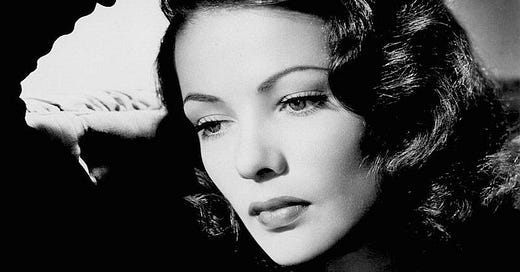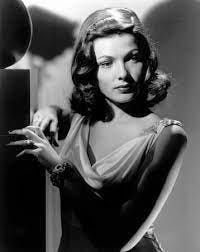Earlier this spring there was a Gene Tierney season at the British Film Institute, showing eleven of the thirty-seven films that she made between 1940 and 1964.
I always wonder what puts some of these ‘season’ ideas into the heads of those who curate them - is it simply the turn of the wheel? The fact that Gene Tierney, who died in 1991 aged 70, had been near-forgotten, therefore she was due to be rediscovered? Anyway the season was a success, which is a lovely thing. Recently I found some notes that I had made about her, a long while ago and I don’t remember why - but I decided to turn them into a piece for here.
Why was I interested in her? For a simple reason. She starred in a film called Laura, which predated my parents’ meeting by many years, but they both liked the theme song - it became what they used to call a ‘standard’ - and it was a factor in choosing my name. So I was aware of Gene Tierney from childhood, and thought her so transcendently beautiful that she has always, for me, been synonymous with the ‘Hollywood star’. Not in the dominant way of a Bette Davis or a Katherine Hepburn, whose personalities shaped the concept; Gene was its passive embodiment.
A little later I knew something else about her. A terrible event in her life was reflected in the plot of Agatha Christie’s 1962 novel The Mirror Crack’d from Side to Side (those familiar with the book will instantly guess what this was; I will elucidate further on). In the US this caused problems, and scuppered the lucrative serialization market. ‘Surely it is unnecessarily cruel to set forth Miss Tierney’s problems and sorrows in such a manner’, an American woman wrote to Agatha’s agent, although he denied that there had been any such intent - indeed, the inspiration for the plot had almost certainly arisen from an entirely different quarter. In the first instance, at least. There are resemblances to Gene. One wonders what she thought about the novel when it was published.
BFI season notwithstanding, the name of Gene Tierney lacks the resonance of the great Hollywood film stars, and just a handful of her films are memorable. Yet her story is that of Hollywood itself, and her rise and fall has the simple shape of myth.
No girl was ever physically better-equipped to be a star. Her first husband, the clothes designer Oleg Cassini, called her a ‘genetic marvel.’ She was selected for glory by the head of 20th Century Fox, and she entered the industry when it was about to rise to its efficient heights, with the studio system churning out films – some incidental works of art, most not – that generated attendances of 100 million in 1946 (a figure that had halved by 1950).
But a film star is like the Palace of Versailles, carrying within the seeds of its own destruction. All beauty is vulnerable. Gene Tierney was one of the most beautiful and the most vulnerable of them all. She is not typical, because there is no such thing. Yet she is, to my mind, generic.
The female film star is one of the great inventions of the 20th century; not to dismiss her male counterpart, but at its height the industry’s magic lay within the woman’s lustrous chiaroscuro gleam. Today, when the concept is over a hundred years old, much has changed: stars rightly seek control of their careers, and are enabled by evolving attitudes/cosmetic intervention to prolong them, although the kind of films that make real money have scant respect for the enigma of femininity. The stars of Hollywood’s golden age worked within the studio system, for the studio bosses, which was not always easy. But the control that the system exerted gave protection; and, on screen at least, women were revered.
Who could watch films like The Women, The Philadelphia Story, His Girl Friday, To Have and Have Not or Leave Her to Heaven (for which Gene received her only Oscar nomination) and think that these female stars were presenting an image of disempowerment? They were never, as women all too often were in the 1960s, mere adjuncts, birds (nobody ever called Katherine Hepburn a bird); nor as in the 1970s subjected to systematic on-screen violence (imagine Straw Dogs with Lauren Bacall. Not happening). Their strength was of the pre-feminist kind, that is to say springing from an acknowledgement of vulnerability; but it was magnificent, and it was at the heart of their magnetism. Although the price that they paid for staying in the game was sometimes very high, in return they were allowed to become goddesses.
And whether or not individual names are half-forgotten, the image of the Hollywood film star is imperishable. As the BFI season has proved. Even now we are like the detective in the 1944 film Laura, mesmerized by a portrait of Gene Tierney, whom he believes to have been murdered: we are haunted by the images of dead girls.
Keep reading with a 7-day free trial
Subscribe to Laura Thompson’s Substack to keep reading this post and get 7 days of free access to the full post archives.





